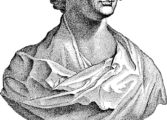Gustav Wied – Portraying the Danish Society through Art

Introduction:
Gustav Wied, born on March 6, 1858, was a Danish author, playwright, and painter. His works provided a unique and critical perspective on the Danish society of his time. This article aims to delve into the life and artistic journey of Gustav Wied, highlighting his importance for anyone interested in Danish culture and society.
Gustav Wied – A Brief Introduction:

Gustav Wied was a multifaceted artist who made significant contributions to Danish literature and visual arts. Born into a noble family, Wied used his privileged upbringing and education to challenge societal norms through his works. His keen observations and wit allowed him to depict the everyday life of the common people, exposing both their virtues and vices.
Historical Development:
1. Early Life and Education :
– Gustav Wied was born in the province of Funen, Denmark, where he developed an early interest in the arts.
– He attended the Royal Academy of Fine Arts in Copenhagen, honing his skills as a painter.
– Wied’s exposure to literature, theater, and social issues during his studies shaped his subsequent artistic endeavors.
2. Literary Success :
– Wied gained popularity as a writer through his novels, plays, and short stories.
– His works often explored the theme of societal hypocrisy and the struggles faced by the lower classes.
– Notable works include “The Family Kronike,” “Livsens Ondskab,” and “Knagsted.”
3. Transition to Visual Arts :
– Despite his initial success as a writer, Gustav Wied turned to visual arts to complement his storytelling.
– He explored various techniques, including painting, drawing, and lithography, to capture the essence of his narratives.
– Wied’s artworks often portrayed everyday scenes, emphasizing the struggles and flaws of the working class.
4. Satire and Social Critique :
– One of Wied’s remarkable contributions was his ability to blend satire with social critique in both his writings and artwork.
– He exposed the hypocrisy and pretentiousness of the upper classes while sympathetically portraying the struggles of the lower classes.
– Through his biting humor and sharp observations, Wied challenged societal norms, sparking debates and discussions.
5. Legacy and Influence :
– Gustav Wied’s works continue to resonate with audiences today, highlighting the enduring relevance of his social commentary.
– His ability to capture the complexities of Danish society and present them in a relatable manner ensures his place in Danish literary and artistic history.
– Many artists and writers have drawn inspiration from Wied’s unique style, contributing to the ongoing exploration of societal themes in Danish art.
Conclusion:
Gustav Wied’s contributions to Danish culture and society are immeasurable. His thought-provoking works continue to captivate audiences and offer valuable insights into the human condition. Whether through his novels, plays, or visual artworks, Wied’s ability to expose the flaws and virtues of Danish society sets him apart as a significant figure in Danish art history.
References:
1. Hansen, Peter H., and Peter Nissen. “Gustav Wied – Dansk biografisk Lexikon.” https://biografiskleksikon.lex.dk/Gustav_Wied
2. “Gustav Wied.” https://www.kulturarv.dk/kid/VisWeilbach.do?kunstnerId=10189&wsektion=alle
















































